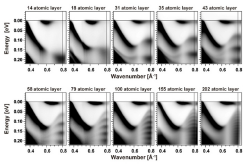Solving the Mystery of the Topology of Semimetal Bismuth
I. Matsuda, Shin, and Komori Groups
Today, bismuth has become a central element in designing and in synthesizing topological materials such as Bi1−xSbx, Bi2Se3, and Na3Bi. However, topology of the pure bismuth crystal has been still controversial. This is because the topology identification requires a precise determination of band structure of the bulk and edge-states of a material but the very small energy gap and the sharp dispersion have prevented from it even with recent photoemission spectroscopy techniques. In order to overcome the situation, we intentionally fabricated electronic interferometry in the bismuth films and combined with the ultrahigh-resolution measurement of angle-resolved photoemission spectroscopy ARPES [1].

Fig. 1. Photoemission band diagrams of pure bismuth crystals measured at hν=8.437 eV. The film thickness is systematically increased from 14 to 202 atomic layer. An atomic layer corresponds to bilayer (BL), 1 BL=3.93 Å.
Figure 1 shows the ARPES results of the processed Bi crystals, normally a three-dimensional substance into an atomically thin two-dimensional film. The films was grown on the Ge(111) substrate. Electrons in a solid behave as electronic waves with a specific wavelength and energy. At all the thickness, a dispersion curve of the edge-state is observed at the Fermi level. On the other hand, at individual thickness, one can find different interference patterns of the electronic waves that are confined in the film. The systematic variation of the pattern allows us to determine the bulk band dispersion accurately. Then, from the precise electronic structures of the edge and the internal bulk, the pure bismuth crystal was unambiguously found to have the nontrivial topology, solving the long mystery [2].
References
- [1] S. Ito, B. Feng, M. Arita, A. Takayama, T. Someya, W.-C. Chen, C.-M. Cheng, C.-H. Lin, S. Yamamoto, T. Iimori, H. Namatame, M. Taniguchi, S.-J. Tang, F. Komori, K. Kobayashi, and I. Matsuda, Phys. Rev. Lett. 117, 236402 (2016). (editor’s choice).
- [2] Research highlight, Nature Physics 13, 8 (2017).
